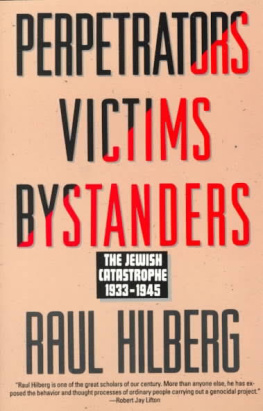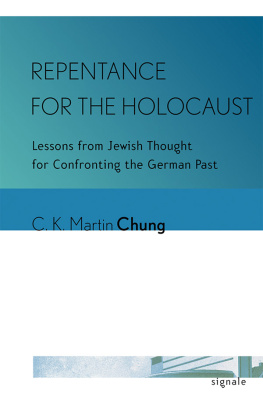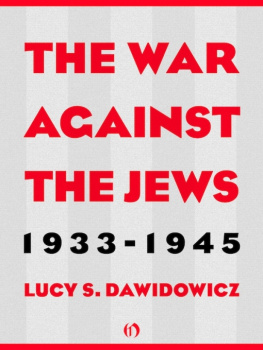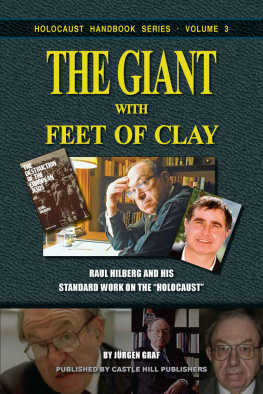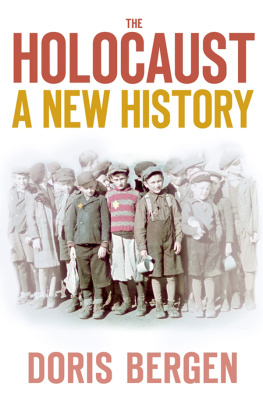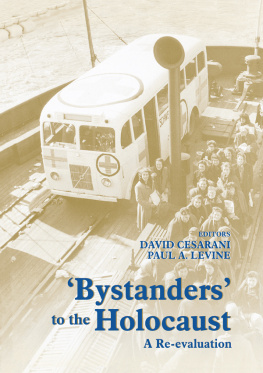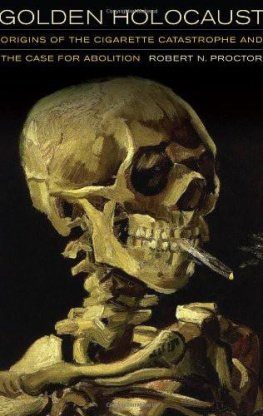Raul Hilberg - Perpetrators Victims Bystanders: The Jewish Catastrophe 1933-1945
Here you can read online Raul Hilberg - Perpetrators Victims Bystanders: The Jewish Catastrophe 1933-1945 full text of the book (entire story) in english for free. Download pdf and epub, get meaning, cover and reviews about this ebook. year: 1993, genre: Non-fiction. Description of the work, (preface) as well as reviews are available. Best literature library LitArk.com created for fans of good reading and offers a wide selection of genres:
Romance novel
Science fiction
Adventure
Detective
Science
History
Home and family
Prose
Art
Politics
Computer
Non-fiction
Religion
Business
Children
Humor
Choose a favorite category and find really read worthwhile books. Enjoy immersion in the world of imagination, feel the emotions of the characters or learn something new for yourself, make an fascinating discovery.
- Book:Perpetrators Victims Bystanders: The Jewish Catastrophe 1933-1945
- Author:
- Genre:
- Year:1993
- Rating:4 / 5
- Favourites:Add to favourites
- Your mark:
- 80
- 1
- 2
- 3
- 4
- 5
Perpetrators Victims Bystanders: The Jewish Catastrophe 1933-1945: summary, description and annotation
We offer to read an annotation, description, summary or preface (depends on what the author of the book "Perpetrators Victims Bystanders: The Jewish Catastrophe 1933-1945" wrote himself). If you haven't found the necessary information about the book — write in the comments, we will try to find it.
Raul Hilberg: author's other books
Who wrote Perpetrators Victims Bystanders: The Jewish Catastrophe 1933-1945? Find out the surname, the name of the author of the book and a list of all author's works by series.
Perpetrators Victims Bystanders: The Jewish Catastrophe 1933-1945 — read online for free the complete book (whole text) full work
Below is the text of the book, divided by pages. System saving the place of the last page read, allows you to conveniently read the book "Perpetrators Victims Bystanders: The Jewish Catastrophe 1933-1945" online for free, without having to search again every time where you left off. Put a bookmark, and you can go to the page where you finished reading at any time.
Font size:
Interval:
Bookmark:
Raul Hilberg is the most widely respected historian of the Holocaust. (His monumental three-volume The Destruction of the European Jews is recognized as the definitive work on the subject.) In this new book, the fruit of a lifetimes research and reflection, he carries the reader along with the narrative flow of the best fiction. Perpetrators Victims Bystanders is truth, but like a novel, it focuses on people people in all three categories of the title. We learn who they were and what they did and did not do. And what was done to them. The calm with which the author describes the most appalling events and the most terrible ironies is uncanny. He never raises his voice, never embroiders language, never strives for effect. He merely tells these stories that must be told, in one unflinchingly pure, clear sentence after another. Hilberg cannot, of course, cover everyone or everything, but all readers of this book, no matter how much or how little knowledge they may bring to it, will come away with an enhanced understanding of how this great human catastrophe happenedand with an unforgettable experience.
VICTIMS
BYSTANDERS
THE JEWISH CATASTROPHE
1933-1945
RAUL HILBERG
Aaron Asher Books
HarperCollinsPublishers
perpetrators victims bystanders. Copyright 1992 by Raul Hilberg. All rights reserved. Printed in the United States of America. No part of this book may be used or reproduced in any manner whatsoever without written permission except in the case of brief quotations embodied in critical articles and reviews. For information address HarperCollins Publishers, Inc., 10 East 53rd Street, New York, NY 10022.
HarperCollins books may be purchased for educational, business, or sales promotional use. For information, please write: Special Markets Department, HarperCollins Publishers, Inc., 10 East 53rd Street, New York, NY 10022.
FIRST EDITION
Designed by Jessica Shatan
Library of Congress Cataloging-in-Publication Data
Hilberg, Raul, 1926-
Perpetrators victims bystanders : the Jewish catastrophe,
1933-1945 I Raul Hilberg.
p. cm.
Includes index.
ISBN 0-06-019035-3
1. Holocaust, Jewish (1939-1945) 2. Holocaust, Jewish
(1939-1945)Biography. I. Title.
D804.3.H56 1992
940.53'18dc20 92-52551 92 93 94 95 96 AC/RRD 10 987654321
for Gwendolyn
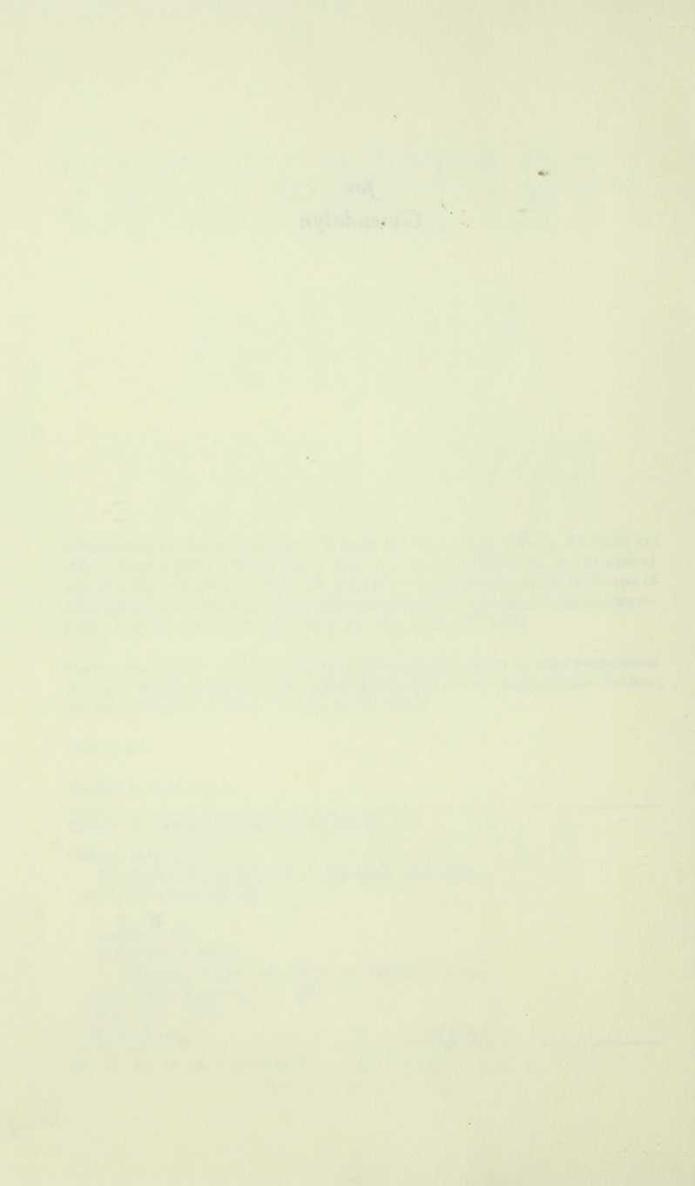
CONTENTS
Preface ix
Part I Perpetrators
Part II Victims
15 The Advantaged, the Strugglers, and the Dispossessed
Part III Bystanders
viii Contents
PREFACE
The Jewish catastrophe during the years from 1933 to 1945 was a massive occurrence. It began in Germany and ultimately engulfed an area encompassing most of the European continent. It was also an event that was experienced by a variety of perpetrators, a multitude of victims, and a host of bystanders. These three groups were distinct from one another and they did not dissolve in their lifetime. Each saw what had happened from its own, special perspective, and each harbored a separate set of attitudes and reactions.
The perpetrators were people who played a specific role in the formulation or implementation of anti-Jewish measures. In most cases, a participant understood his function, and he ascribed it to his position and duties. What he did was impersonal. He had been empowered or instructed to carry out his mission. Moreover, no one man and no one organization was solely responsible for the destruction of the Jews. No single budget was allocated for this purpose. The work was diffused in a widespread bureaucracy, and each man could feel that his contribution was a small part of an immense undertaking. For these reasons, an administrator, clerk, or uniformed guard never referred to himself as a perpetrator. He realized, however, that the process of destruction was deliberate, and that once he had stepped into this maelstrom, his deed would be indelible. In this sense, he would always be what he had been, even if he remained reticent or silent about what he had done.
The first and foremost perpetrator was Adolf Hitler himself He was the supreme architect of the operation; without him it would have been inconceivable. Hitler was always in the limelight, but most of the labor was carried out in the shadows by a vast establishment of familiar functionaries and ascending newcomers. In this conglomeration, some men displayed eagerness, while others had doubts. Within the leadership there were many professionals, including ubiquitous lawyers and indispensable physicians. When the process was extended to the four corners of Europe, the machinery of destruction became international as Germans were joined by governments in satellite states and by individual collaborators in occupied countries.
Unlike the perpetrators, the victims were perpetually exposed. They were identifiable and countable at every turn. To be defined as Jews, they only had to have had Jewish parents or grandparents. Discriminatory laws and regulations dealt in great detail with such problems as partners in mixed marriages, individuals with mixed parentage, and enterprises with mixed ownership. With each successive step, the gulf became wider. The Jews were marked with a star, and their contacts with non-Jews were minimized, formalized, or prohibited. Segregated in houses, ghettos, or labor camps, they were spatially isolated and concentrated. Beyond these barriers, the war cut off continental European Jewry from Jewish communities and Allied governments in the outside world.
The Jewish victims had leaders, and these individuals, occupying positions in hundreds of Jewish councils, have attracted much attention. The victims as a whole, however, have remained an amorphous mass. Millions of them suffered a common fate in front of pre-dug graves or in the darkness of hermetically sealed gas chambers. The death of these Jews has become their most important attribute. They are remembered mainly for what happened to them all, and for this reason there has been some inhibition about segmenting them systematically into component categories. Yet the impact of destruction was not simultaneously the same for everyone. There were, first of all, people who left in timethe refugees. The vast majority, who stayed or were trapped in place, included grown men and women, whose respective encounters with adversity were not identical. Some of the married Jews were in a special category, because they had non-Jewish partners. Jewish children had lives and afflictions all their own. The quandary for Christians of Jewish descent is a story in and of itself. The community as a whole was stratified from top to bottom in terms of wealth and income, and in many situations these material distinctions mattered a great deal. Even more significant were differences of personality traits. Whereas most victims adjusted themselves step by step to the increasing stringency of deprivation and loss, there was a minority, however small, that did not share the adaptations of the multitude. The inability or refusal to become reconciled to the assault gave rise to a variety of reactions, from suicides to open rebellion. Finally a remnant of persisters and resisters were found alive in the liberated camps and woodssurvivors.
Most contemporaries of the Jewish catastrophe were neither perpetrators nor victims. Many people, however, saw or heard something of the event. Those of them who lived in Adolf Hitlers Europe would have described themselves, with few exceptions, as bystanders. They were not involved, not willing to hurt the victims and not wishing to be hurt by the perpetrators. Yet the reality was not always so uncomplicated. Much depended on the relations of various continental European nations with the Germans and with the Jews. These bonds or fissures could facilitate or hinder action in one direction or another. Much was determined also by the character of the individual, particularly if it was an unusual or extraordinary character. In some areas, bystanders became perpetrators themselves. In many regions they took advantage of Jewish misfortunes and seized a profit, but there were also those who helped the hunted. Now and then, a messenger appeared and spread the news.
Next pageFont size:
Interval:
Bookmark:
Similar books «Perpetrators Victims Bystanders: The Jewish Catastrophe 1933-1945»
Look at similar books to Perpetrators Victims Bystanders: The Jewish Catastrophe 1933-1945. We have selected literature similar in name and meaning in the hope of providing readers with more options to find new, interesting, not yet read works.
Discussion, reviews of the book Perpetrators Victims Bystanders: The Jewish Catastrophe 1933-1945 and just readers' own opinions. Leave your comments, write what you think about the work, its meaning or the main characters. Specify what exactly you liked and what you didn't like, and why you think so.

